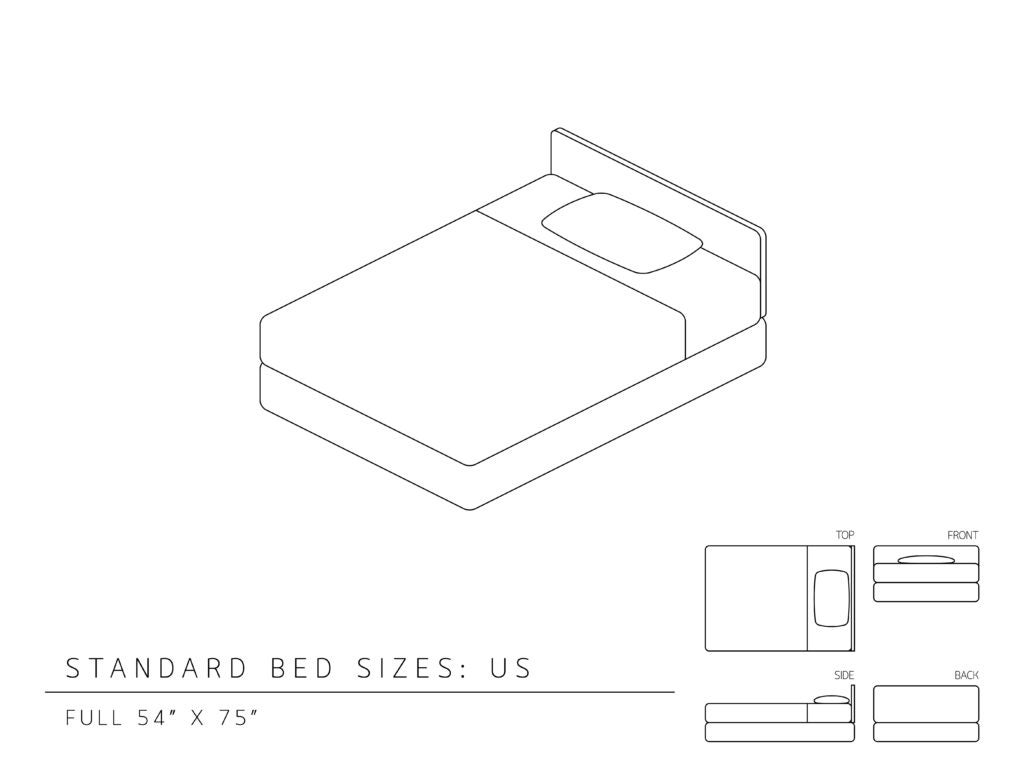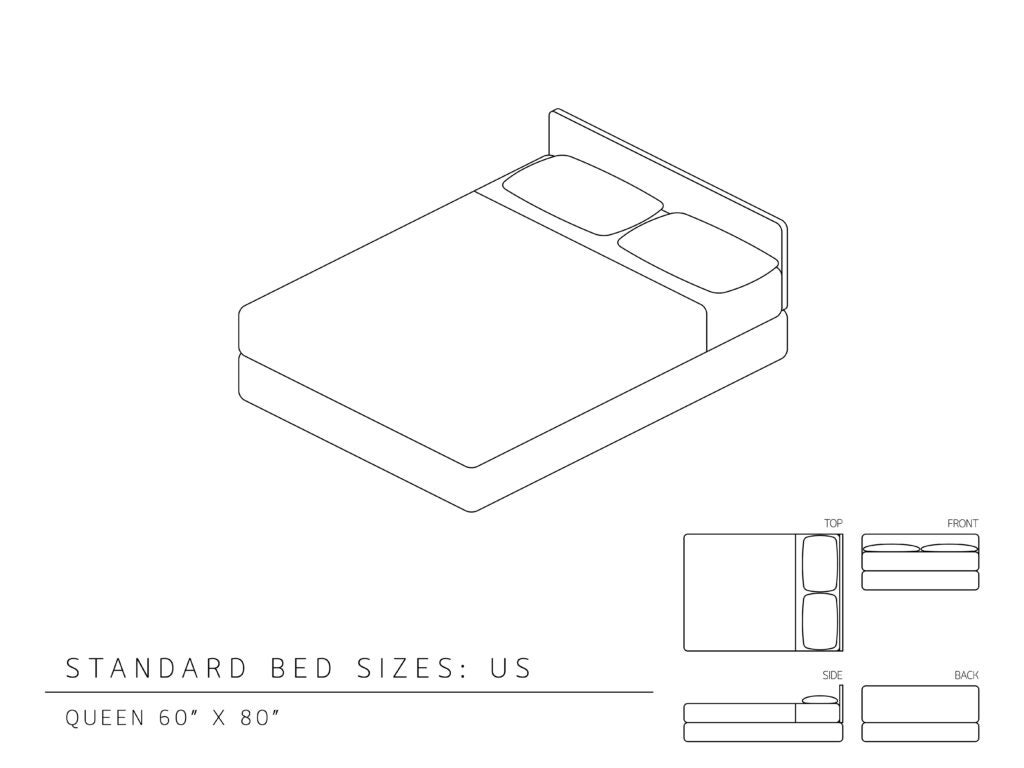For years, the full bed was the preferred mattress for most people. In recent years, however, the queen has been growing in popularity. This begs the questions when it comes to full vs queen, which bed size is best for you?
Both have some advantages and disadvantages over the other, but much of it depends on you and your home. Do you sleep alone? Do you have a large room? Is money an option? We’ll look at the differences and figure out which will work best for you.
What is a Full Bed?
The full mattress is the smallest of the standard mattress sizes after the twin. The jump between the two is pretty large, with the full mattress at 54 inches wide, 16 inches wider than the twin. Considering this, it’s a pretty significant upgrade. While this used to be a popular mattress size, it has lost traction in recent years to the larger queen bed.
The Pros and Cons
Pros
- Relatively low cost
- Easy to find accessories
- Not too heavy
Cons
- Not ideal for couples
Size
One of the best parts of the full bed is that it provides a good amount of room without taking up a significant amount of space. Though not as compact as a twin, it can still fit comfortably in most bedrooms. It’s safe to say you’ll be able to still have a fair amount of space to maneuver in your room if you go with a full-size mattress.
Comfort
The full bed is mostly considered as a bed for someone sleeping alone. Its width only leaves 27 inches for each person, should two people be sleeping in it. This can work, but it’s certainly not ideal. In truth, a full bed gives a lot of room for one person. You can stretch out, a lot, which is great. It is, however, five inches shorter than the queen and king size mattresses, so if you’re a taller person, you may want to think about upgrading.
Accessories
The full-size mattress is incredibly common, and sets for it are fairly inexpensive. You can get a nice duvet set at one of the big box stores or online retailers starting at around $20. You’ll also have room for an extra pillow or two, which is never a bad thing.
Recommended Room Sizes:
For a full-size bed, you’ll want a room that’s about 10 feet by 12 feet. If you’re working with something smaller than 9 feet by 9 1/2 feet, a twin might work out better. This, of course, depends on any furniture you may have and how much walking room you would like.
What is a Queen Bed?
The queen is now the dominant bed in America. It offers more legroom and is a bit wider than the full, though not as wide as you may expect. At 60 inches wide, it’s only six inches wider than the full, but it also adds five inches to the height.
The Pros and Cons
Pros
- Good for couples
- Easy to find accessories
- More leg room
Cons
- Can be more expensive
- Heavy
Size
Since it’s not a whole lot bigger than the full, a queen is still good for most rooms. Where you might run into issues is the additional length. If you found that a full-size bed fit perfectly between a wall and a door, for instance, upgrading to a queen could cause issues. (I bring this up because I had it happen to me.)
Comfort
For a single person, a queen is probably overkilled. But, I’ll admit, more room is never a bad thing. If you find yourself moving around a lot or if you just want to be able to get lost in your sheets, maybe a queen will work for you. For two people, the queen works pretty well. Its width allows for 30 inches for each sleeper. This is nine inches less than a twin offers, which sounds like a lot, but 30 inches is still a fair amount of room.
Accessories
Since the queen is one of the more common sizes, finding items to put on it is a breeze. You can find them anywhere and without paying too, too much. They are going to be a bit more expensive than the full, with sheet sets starting at about $20. However, many of the duvet sets out there are actually full/queen, so they run on the lower end of pricing.
Recommended Room Sizes:
If you’re looking at a queen, a similar-sized room would work, but your minimum bumps up to about 9 1/2 feet by 10 feet. Anything below that and you’re going to feel a little cramped. Anything 10 feet by 10 feet and above will work out pretty well, depending on the furniture and walking room.
See related article here
Full vs Queen Comparison Table
| Full | Queen |
| Easier to move | Harder to move, but not much |
| Good for one person | Wider and longer |
| Cheap sheets | Sheets are more expensive |
| 54” x 75” | 60” x 80” |
The Verdict
Considering the similarities between the two, making a hard and fast decision is somewhat difficult. The extra legroom of the queen is nice, but I don’t know that the additional six inches are worth the price difference, which can be significant. But even the price difference depends on the mattress you want to buy. I’ve seen some in which the price difference is literally $0, and others where it’s several hundred dollars.
If I was forced to make a decision, which I am now forcing myself to do, I would go with a queen mattress. Finding a good, affordable one for a decent price means you’ll have that extra room for yourself or just enough room for you and your partner.
If you don’t sleep alone and think you’re going to need a bit more room than a full or a queen can offer, it might be in your best interest to look at a king, which is a much larger jump in width.
Photo credit: Artazum/Shutterstock; paitoon/Shutterstock
Frequently Asked Questions
Is a full size mattress different from a double size mattress?
Full and double are two different names that are used to describe the same size bed. Because the two names are still in popular use, mattress companies often refer to them interchangeably. Interesting factoid: Up until the 1940s, the two most popular mattress sizes were twin or double (full). In the 1950s, queen and king size beds were introduced to consumers as alternative choices to a double bed and by 1999, queen size mattresses became more popular than full size.
If queen size mattresses are more popular, why would anyone buy a double size?
While it is true that queen size mattresses are the most sought-after choice, there are many reasons why a full size would be a better option. Firstly, many teens grow out of their twin-size pre-teen bed, but find a queen size too large. This is where a full-size mattress would be a good choice, lasting a teen a good 10 to 15 years, depending on the quality, long enough for when they reach adulthood and want something bigger to share with a partner. Other reasons why a double bed would be a better choice than a queen would be to fit into a larger dorm room, a first apartment, a guest room or a smaller bedroom for two people.
Is it safe for a child to have a queen-size mattress?
There is no reason why a child over the age of four shouldn’t sleep in a queen size bed. Although it’s not typical, if the bedroom is large enough to accommodate a queen mattress and furniture, then the bed will give your child plenty of space to stretch out and move around. A queen mattress will also be more comfortable if now and then your little one needs you lying by his or her side to fall asleep after a nasty dream. It is also more spacious for you to comfortably read a good-night story and allows room for bed mates such stuffed animals and the family dog or cat.
Is the size of the bed frame important when choosing a fulll or queen mattress?
While the dimensions of a bed frame should roughly match the mattress size, it will have a few extra inches added to the width and the length. This is done to make space for the bedding, so you can lift the mattress to put on the mattress cover and fitted sheet. The design of the bed frame will also be a factor in its size. Before choosing between a double or a queen mattress, factor in the size of the bed frame and add that to the overall amount of space you will need to fit it all comfortably into your room. If you thought a queen mattress would fit but you didn’t take into account the size of the bed frame, you may be sorely disappointed in the end result.

